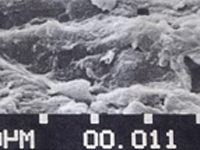| Peat
|
||
peat under the microscope |
||
|
Peat is a substance formed by dead plant matter. Plants are decomposed by microorganisms after they die. The decomposed matter is returned to the soil. In most ecosystems, plant matter is completely decomposed within a short period of time. However, such is not always the case. In a peat-forming ecosystem, plant matter decomposes slowly. This results in an accumulation of organic matter called peat. Wetlands are ideal places for the formation of peat because their waterlogged condition helps slowing down the rate of decomposition. Peat formed in different locations have different properties. Among different kinds of wetlands, Sphagnum-covered bogs are most likely to have a thick accumulation of peat. Sphagnum releases acids that are partly responsible for suppressing the growth of bacteria and other organisms capable of decomposition. The image to the right is a sample of peat viewed with very high-resolution microscopes. Peat is not a homogeneous substance. Its structure varies with the depth at which it is located. The top layer of peat is usually very fibrous. This image shows the fibers in the peat are interwoven into a sponge-like material. Like a sponge, there are many pores within, which are responsible for the water-absorbing quality of peat. |
|

|